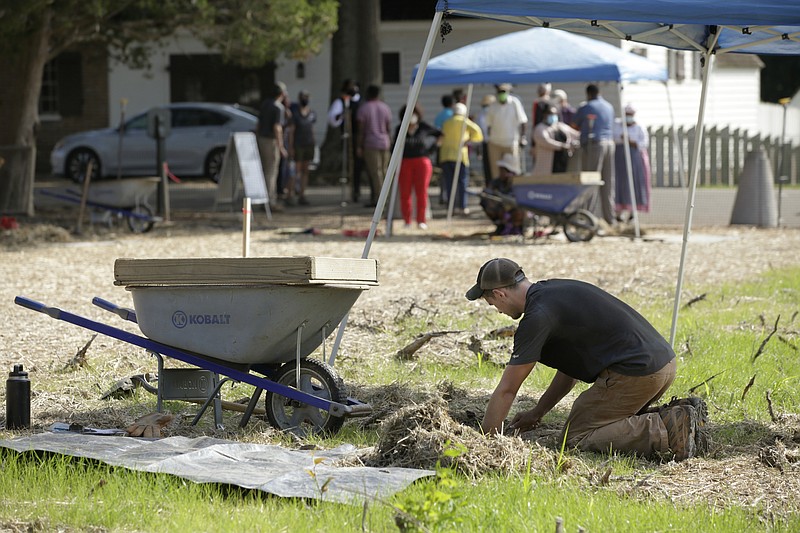Archaeologists have found evidence of at least two graves, along with artifacts such as an ink well, fragments of a doll and building foundations, during a dig at the site of a historic Black church in Colonial Williamsburg, officials said Monday.
The discoveries were made in late summer and early fall beneath a parking lot on Nassau Street at the former location of the old First Baptist Church. One of the oldest Black churches in the country, it had buildings on the spot in 1856, and perhaps as early as 1818. It was organized in 1776.
Evidence of two grave shafts have been found, Jack Gary, Colonial Williamsburg's director of archaeology, told an online community meeting Monday morning.
And community members were asked if they wanted archaeologists to probe the graves, and remove any possible remains to try to identify who is buried there.
In 1953, when the church planned to build an adjacent annex, a member of the congregation, "Sister Epps (Most likely Mrs. Fannie Epps)," said her great-grandfather was buried where the annex was supposed to go, researchers have said.
Gary said Monday the likely graves are right where Epps said her relative was buried.
The 1856 church -- whose bell was used to dedicate the National Museum of African American History and Culture in Washington four years ago -- was torn down in the 1950s. But its foundation and that of two earlier structures, one possibly a privy, have been detected underground.
It is the earliest Black church in Williamsburg, experts said.
When Colonial Williamsburg was being organized as a tourist attraction in the early and mid-1900s, during a time of entrenched racial segregation, the story of a post-Colonial Black church did not fit the Colonial narrative, church descendants have said. A plaque was placed at the site in 1983.
According to the congregation's tradition, enslaved and free Black people began meeting secretly in the woods to pray and listen to a minister named Moses, and later to an enslaved tavern worker and preacher named Gowan Pamphlet.
When Pamphlet, a Baptist, was ordained in 1772, he was the "only ordained black preacher of any denomination in the country," according to Colonial Williamsburg.
And it was perhaps around that time that he began to lead meetings of the rural Black congregation outside town.
Williamsburg was the capital of Virginia from 1699 to 1780, and by 1775, more than half of its 1,880 residents were Black, most of them enslaved, according to historian Linda Rowe.
The church congregants had to meet in remote locales outdoors. It was dangerous for Black people to gather in numbers anywhere, for fear of arousing white suspicions of revolt.
Moses, the original preacher, was regularly whipped for holding religious meetings, Rowe wrote.
Pamphlet's enslaver, Jane Vobe, ran the King's Arms Tavern on Duke of Gloucester Street, across from the Raleigh Tavern, a popular venue for auctions of enslaved people, Rowe wrote in the Virginia Magazine of History and Biography.
Pamphlet's congregation continued to grow anyway, to as many as 500 by 1791, Rowe wrote.
And church tradition has it that a local white businessman, Jesse Cole, while walking his lands one day, came upon the congregation meeting and singing in an outdoor shelter made of tree limbs and underbrush.
Moved by the scene, he offered them a carriage house he owned on Nassau Street, according to Rowe.
At that point, the record is cloudy.
In 1818, there is a reference to a "Baptist meeting house" on the spot, according to the project's research. "It is unclear what this building looked like or how long it had been standing on the lot by 1818," researchers have written.
Further mention came in 1834, when a tornado tore through Williamsburg and a Norfolk newspaper reported that the "colored people's meeting house" was blown down.
In 1855, a stately new brick church was built with a steeple and palladian windows.
The church housed a school for Black students in the 1860s. It survived a Civil War battle in 1862 that killed and wounded thousands of men, and filled the town with injured soldiers.
It served its members through the end of slavery, the eras of Reconstruction, Jim Crow racial oppression, segregation and the dawn of the civil rights movement.
The church shows up on a 1921 insurance map labeled "Baptist Church (Colored.)" The map notes that it was heated with "stoves" and illuminated with "lamps."
Colonial Williamsburg subsequently bought the church and tore the old building down in 1955. The site was paved over in 1965. A new church funded by the sale -- First Baptist Church -- was built about eight blocks away in 1956.
After the old church was torn down, a limited archaeological dig was conducted in 1957, Gary, of Colonial Williamsburg, said. Results were modest.
